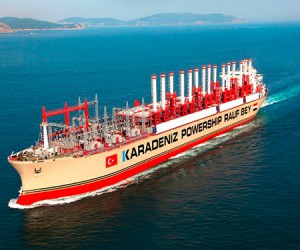Power ships are proving to be a quick-fix temporary solution to electricity constraints around the world. In Africa, they are used to good effect in Ghana. The floating power stations are either anchored off shore or moored at quayside and transmit power through cables or transmission lines.
Port Elizabeth is home to a large slice of South Africa's critical automotive industry, foundries and the deep water port of the Coega Industrial Development Zone. It is an energy hungry region that, in 2012, soaked up 26% of Eskom-produced power, by sales.
If Eskom could ease this demand, power for the rest of the country would stabilise and lower the pressure on the electricity producer. Solutions announced by Eskom are either costly – running diesel generators while maintenance is done on coal-powered plants – or at least 18 months in the future – when newly constructed plants come online.
A quick fix would be power ships like the type that generate 22% of Ghana's power needs. In Lebanon, two Turkish-built power ships supply Beirut with 270MW daily. Lebanon's power demands have increased by between 6% and 8% over the last few years, mostly the result of refugees fleeing the Syrian civil war.
For Beirut, the power ships are a quick-fix solution until demand stabilises or new power infrastructure comes online in three years. Gebran Bassil, Lebanon's energy minister, explained at the inauguration of the first ship: "The power ships do not represent an ultimate solution to the electricity problem but a three-year temporary solution to allow the rehabilitation of [existing, conventional] power plants."
South Africa used a power ship in 2006 when a bolt was lost during routine maintenance at Koeberg, the nuclear power plant in the Western Cape. The amount of power generated by Koeberg was reduced and with load shedding looming, the utility rented a barge-mounted turbine to supply power.
Eskom spokesman Andrew Etzinger told Moneyweb that power ships were not a solution the utility was considering. In the short term, he argued, power ships would help to alleviate the supply problem but at a cost equal to what Eskom spent on running its diesel turbines.
Eskom produces 34 000MW of power, which just about meets the country's power needs. A Karadeniz power ship would produce about 310MW, which is "capable of powering a town like East London. The idea is not to make a town self-sufficient, but rather to feed the electricity into the national grid."
The biggest builder of power ships is Turkish company Karadeniz. Osman Karadeniz started building floating power stations after leaving West Africa, where he saw persistent power shortages at hospitals lead to unnecessary deaths. Chronic power shortages meant development was hampered, miring the region in a cycle of poverty. "The concept behind it was how to provide affordable power in some West African countries where there [was] no infrastructure, not even a hardware store," Karadeniz wrote on the company's website.
Karpowerships can go live – according to the website – within 120 days. The floating power stations are either anchored off shore or moored at quayside and transmit power through undersea cables or transmission lines. Currently the company's technology allows a station to operate for 12 hours a day in a 12-day cycle. When it runs out of power it draws energy from a storage ship moored next door, in essence a floating battery.
There are at least 60 floating power stations around the globe that use natural gas, heavy fuels and even nuclear to produce 4GW of power. In the north of the Russian Federation, a floating nuclear power station, with a 40-year lifespan, produces 70MWs of power that is transported 290 kilometres inland.
Taking 2010 as a base figure, Eskom produced 101.1% of South Africa's power needs in 2011. That figure slumped to 99.3% in 2012. By July 2013, Eskom was producing 106.4% but slid to 97.3% by September. It was not until July 2014 that it breached the 100% mark again.
Power production has sagged again, leaving citizens scratching their heads over confusing load-shedding timetables. But confusion is not the worst of it; Eskom's problems influence the country's growth prospects. While operating on razor-thin power margins, Eskom expects that once its new power plants come online demand will be met, with reserve margins once again reaching between 10% and 20%.
In 2014, the International Monetary Fund expected the South African economy would grow by 3.6% in 2015. This prediction was tied to "robust infrastructure investment spending and easing of electricity supply constraints as additional electricity supply from new power plants [begins] to come on stream". At the same time, the CIA Factbook warned that growth in South Africa would not exceed 3% until the country found new sources of stable abundant power.
Sulaiman Philip










